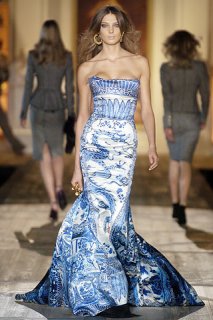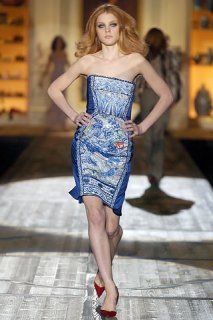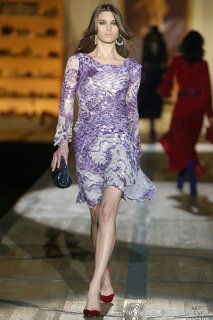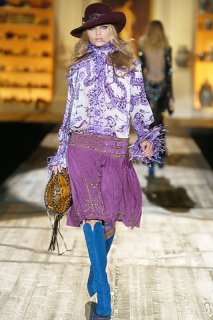New article on Shanghai Tang.
http://uk.biz.yahoo.com/051201/244/fyc62.html
Shanghai Tang: A Taste of China
By Reena Jana
China's first luxury brand hasn't had a smooth international ride. Launched in Hong Kong in 1994, Shanghai Tang opened a ritzy 12,500-square-foot New York flagship store on Madison Avenue in 1997, closed it less than two years later due to
Advertisement
sluggish sales, and quietly relocated to a smaller location in 2001. But four years after the arrival of new CEO Raphael le Masne de Chermont and Creative Director Janice Ooi, Shanghai Tang seems to be back on track.
While le Masne won't disclose figures, he says worldwide sales have grown 43% in the last year, and American sales [at boutiques in New York and Honolulu] are up 50%. Compagnie Financiere Richemont (Virt-X: CFR.VX - news) -- the Swiss luxury goods company that bought a majority stake from founder David Tang in 1998 -- has embarked on an ambitious expansion plan [see BW, 7/21/03, "Richemont in a Rut"]. In 2005, new stores opened in Zurich, Shanghai, Tokyo, and Bangkok.
Currently, two more, in Beijing and Milan, are set to open in 2006. "We expect to have 30 stores by the end of 2007," le Masne says. "Among the 10 boutiques we plan to open, I can say that four will be in China, and two will be in the U. S. -- starting in Las Vegas, and then either San Francisco or Los Angeles."
LUXURY BOOM.
Shanghai Tang's success is due in part to the strength of the Asian market, which is responsible for 80% of the brand's sales. Parent company Richemont's latest annual report states that overall sales in Asia [outside of Japan] grew 20%, compared to 10% in Europe, 7% in the Americas, and 3% in Japan, for the fiscal year that ended in March. [The report notes that the SARS epidemic slowed sales in 2003-04, which could have contributed to such a dramatic spike the following year.]
And a 2005 Ernst & Young analysis of luxury-goods consumption estimates that sales in China will grow 20% annually from 2005 to 2008. By 2015, Ernst & Young predicts, China will overtake the U.S. as the world's second-highest consumer of luxury goods, after Japan.
But much of the credit for Shanghai Tang's turnaround also goes to Ooi, the former Asian sales and marketing director for high-end shoemaker Stephane Kelian. To reinvigorate the brand, Ooi set out to create bold design statements that combined Chinese cultural references and sleek, contemporary clothes -- while moving beyond cliched Mao-style jackets.
CHINESE AMBASSADOR.
On a brisk November evening in the New York store, a parade of sylph-like models showcase Ooi's newest designs, which will hit stores in spring, 2006. The collection consists mainly of miniskirted versions of the qipao , a traditional Mandarin-collared dress, rendered in bright hues and emblazoned with patterns based on paintings by artists in Beijing.
"The goal is to be the ambassador of modern Chinese style," says Ooi, who's hard to distinguish from the models. Slim and statuesque at nearly six feet tall, she's as fashionably dressed as the young women wearing her designs. As the models walk silently among the fashion-show audience sipping chardonnay, Ooi shows off a binder filled with photographs of the artworks she commissioned by established Chinese contemporary artists and young art students to serve as inspiration for this collection. "I picked the topic because contemporary art embodies the tensions between old and new China," Ooi says.
"Each season, I choose a theme that the public isn't too aware of," Ooi explains. "I try to stay away from a pastiche of what Westerners think of as Chinese culture." Rather than scan fashion magazines, she does her research at art museums and reads books on period and regional histories. "There's a pedagogical aspect of Shanghai Tang," says Ooi. "People can appreciate the brand on many levels."
"SOFT POWER."
One collection focused on Chinese calligraphy, and Ooi turned traditional characters from Mandarin and Cantonese into decorative patterns. Another set of clothes was inspired by the garments and jewelry worn for centuries by ethnic tribes in China's Hunan province. For yet another collection, Ooi reinterpreted the fur-lined clothing worn by Mongolian and Tibetan nomads. And Ooi based the autumn/winter 2005 collection on the Ming and Qing dynasties, drawing heavily on imperial symbols from the 14th to early 20th centuries, like the color yellow [a royal hue] and a five-clawed dragon [an icon worn only by emperors].
"People ask me, 'Don't you find always working with a Chinese theme limiting?'" Ooi says. "But our brand isn't just about referencing a dynasty every season. My only requirement is a Chinese silhouette, and fabric associated with China."
Now that the country currently possesses what economist Joseph Nye has describes as "soft power," i.e., both economic and cultural cachet, Shanghai Tang could be tapping into newfound awareness of Chinese style. A-list celebrities such as Julia Roberts and Beyonce have been photographed wearing East-meets-West clothing emblazoned with details like Chinese opera-mask motifs by Vivienne Tam, a Cantonese-born, Hong Kong-bred designer based in New York since 1983.
NATIONAL STYLE.
But Ooi is quick to dismiss any association with trendiness. "We're not depending on zeitgeist. We're not the flavor of the month," she says.
The key for Shanghai Tang will be to follow in the tradition of established luxury labels associated with a specific national aesthetic. Labels like Armani, Gucci, Prada, Versace, and Fendi have long symbolized streamlined Italian style. Chanel embodies Parisian elegance. With its booming sales, Shanghai Tang has the chance to become the Chanel of China.


 But it shows that even though it seemed appropriate, HK sadly still has a narrow definition for what items are acceptable in fashion but ironically not composition..
But it shows that even though it seemed appropriate, HK sadly still has a narrow definition for what items are acceptable in fashion but ironically not composition.. )
)




 *LOVE*
*LOVE* 








